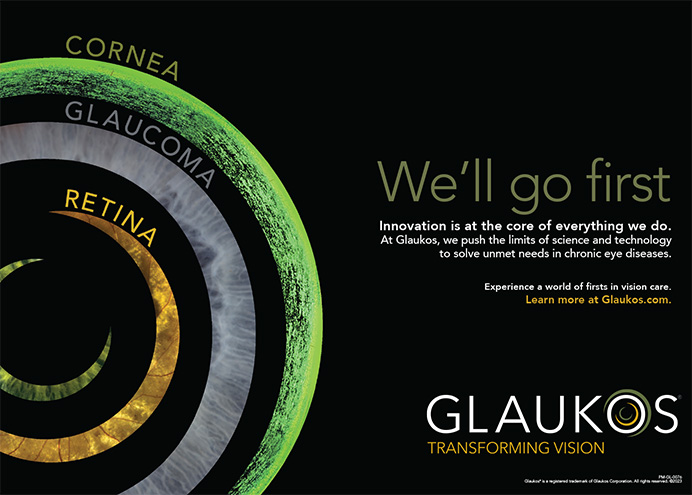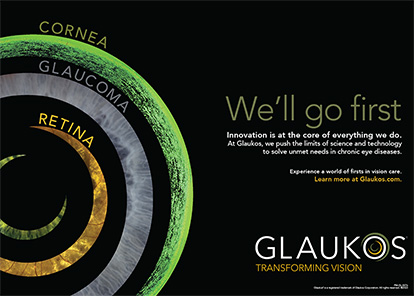The Trulign Toric IOL (Bausch + Lomb) (Figure 1) is a toric modification of the company's Crystalens AO, with the addition of a toric optic on the posterior surface and two axial orientation markings on the anterior surface. Its material composition and overall lens design (ie, 5-mm biconvex optic made of a fourth-generation silicone, two hinged-plate haptics and four polyimide loops) are otherwise identical to the AO model. The lens is intended for primary implantation in the capsular bag of the eye for the visual correction of aphakia and postoperative refractive astigmatism secondary to removal of a cataractous lens in adult patients with or without presbyopia who desire a reduction of residual refractive cylinder with increased spectacle independence and improved uncorrected near, intermediate, and distance vision.
ADDRESSING PATIENTS' UNMET NEEDS
An exciting, distinguishing attribute of the Trulign Toric IOL is that it represents the first and only product available in the United States that addresses two important unmet clinical needs of cataract patients in a single procedure by (1) reducing the visual impact of residual uncorrected astigmatism and (2) uncorrected distance and intermediate vision and functional near vision. Currently available standard toric IOLs such as AcrySof Toric (Alcon Laboratories, Inc.) and the Tecnis Toric (Abbott Medical Optics Inc.) offer astigmatic correction with improved vision at only a single distance. Many patients who receive these lenses will still need glasses for their everyday activities such as working on the computer or reading an iPad (Apple, Inc.)
Figure 2 shows the distribution of corneal astigmatism in 6,000 cataract patients prior to surgery. The results are consistent with numerous studies in various cataract populations that show that between 36% and 39% have more than 1.00 D and between 15% and 22% have more than 1.50 D of preexisting corneal astigmatism.1-7 Based on these data, a substantial proportion of cataract patients could benefit from a toric IOL.
Untreated corneal astigmatism blurs distance and intermediate vision, and residual with-the-rule astigmatism decreases near vision. The need to correct the effect of preexisting corneal astigmatism is paramount if surgeons are to meet patients' expectations of improved uncorrected distance and intermediate vision with functional near vision. An obvious advantage of a toric IOL is that it addresses aphakia and astigmatism in a single procedure. Toric IOLs mitigate some of the disadvantages and potential side effects of incisional or excimer laser vision astigmatic correction, such as variable corneal wound healing and biomechanics, corneal denervation in the cataract population who are already at higher risk, corneal perforation, wound gape, and decreased spectacle-corrected visual acuity resulting from irregular astigmatism.
TRULIGN EFFECTIVELY CORRECTS REFRACTIVE ASTIGMATISM
In the Trulign Toric study, presented to the FDA panel meeting in April 2013, an online toric calculator was utilized, and patients with predicted postoperative astigmatism of between 0.83 and 1.32 D were randomized between a spherical Crystalens control and the Trulign of lowest toric power (1.25 D at the IOL plane). Patients with higher amounts of preexisting corneal astigmatism received the toric model with 2.00 D or 2.75 D toric power at the IOL plane. The results showed an 85.0% reduction in refractive cylinder in the all toric cohorts and a mean of less than 0.50 D of residual refractive cylinder for the 1.25, 2.00, and 2.75 D toric IOLs (Figure 3). The Trulign Toric 1.25 D group was statistically superior to the spherical control both in reduction of percentage of reduction of astigmatism and in uncorrected distance vision (Figure 4).
As previously stated, a unique feature of the Trulign is that it addresses two important clinical needs, one of which is offsetting substantial preexisting corneal astigmatism. The other desire that our patients express is the ability to have improved uncorrected distance and intermediate vision, along with functional near vision. Patients want to be able to drive easily at night, use one of the ever expanding hand held device options, check e-mail on their smartphone, shave, put on makeup and check out their Facebook page on the computer. Many patients do not mind the use of low-powered reading glasses for sustained reading, particularly under low lighting, but want to have great intermediate vision and be able to see who is calling on their smartphone without having to fumble for reading glasses.
In general, monofocal nonpresbyopia-correcting IOLs do not address the intermediate and near needs of patients and leave them dependent on glasses for these tasks. Figure 5 shows the defocus curve of the AcrySof SN60WF monofocal nonpresbyopia-correcting IOL for distance, intermediate, and near vision,8 as well as the results with the standard, monofocal CeeOn 911A IOL (Abbott Medical Optics Inc.) at various vergences.9 In comparison, the mean distance-corrected visual acuities at intermediate and near with the Trulign Toric are 20/22 and 20/39, close to double that of the nonpresbyopia- correcting monofocals. The data for all of the IOLs in this figure are visual acuities obtained through the patient's distance correction. This obviates the effect of any residual refractive error and demonstrates the true inherent performance of each IOL as if each patient had achieved a perfect plano refractive outcome. This enhanced through-focus with the Trulign Toric is also evidenced by the lower 1.45 D required near spectacle add for the Trulign Toric IOL compared with the 2.50 D required near spectacle add for the monofocal nonpresbyopia-correcting IOLs.
ROTATIONAL STABILITY
The key essential element, the “secret sauce,” so to speak, of an effective toric IOL, is its rotational stability. This is because, as is well accepted, every degree of misalignment of a toric IOL results in a 3.3% reduction in offset of astigmatism. That means a 10º misalignment reduces the toric effect by one-third.
In the FDA clinical study of the Trulign Toric IOL, 96.1% of eyes had 5º or less rotation between the day of surgery and 4 to 6 months postoperatively compared with 81% with the AcrySof Toric. No eye had greater than 10° of rotation, and the mean rotation was less than 2º for the Trulign Toric. In summary, the Trulign Toric IOL demonstrate exquisite rotational stability.
REFRACTIVE PREDICTABILITY
As evidence of the lens' outstanding refractive targeting predictability, nearly 80% of the Trulign Toric group was within 0.50 D of the intended manifest refraction spherical equivalent versus 55% with the AcrySof Toric, and more than 95% of the Trulign Toric group were within 1.00 D (Figure 4). The mean monocular distance visual acuity in the eyes implanted with the Trulign Toric IOL was 20/25, the mean uncorrected intermediate visual acuity was 20/22, and the mean uncorrected near visual acuity was 20/39.
NO ASSOCIATED INCREASE IN VISUAL DISTURBANCES
The study showed that there were no new safety concerns or an increase in visual disturbances associated with the toric modification. Only one patient reported significant visual disturbances in the toric group, which resolved after Nd:YAG laser treatment of moderate posterior capsular fibrosis. The increase in photic phenomenon, halos, and night glare more frequently associated with multifocal IOLs was not seen with this platform. While anterior or asymmetric vault represent an uncommon but known complication inherent to hinged plate-haptic IOLs, the incidence of this complication can be mitigated by a central, round capsulorhexis; careful attention to capsular polishing, including the underside of the anterior capsular leaflets; meticulous cortical cleanup; and a low threshold to perform Nd:YAG laser treatment if capsular striae, fibrosis, or slit-lamp signs of vaulting are seen.
CONCLUSION
The availability of the Trulign Toric reflects a new paradigm in toric IOL platforms in that it effectively reduces refractive astigmatism, demonstrates both outstanding rotational stability and refractive predictability, and provides improved uncorrected distance and intermediate vision and functional near vision all in a single device and procedure.
Jay S. Pepose, MD, PhD, is founder and director of the Pepose Vision Institute, Chesterfield, Missouri, and a professor of clinical ophthalmology and visual sciences at the Washington University School of Medicine in St. Louis. He is a consultant to Abbott Medical Optics Inc. and Bausch + Lomb, and he served as medical monitor for the Trulign Toric IOL clinical trial. Dr. Pepose may be reached at (636) 728-0111; jpepose@peposevision.com.
- Chen W, Zuo C, Chen C, et al. Prevalence of corneal astigmatism before cataract surgery in Chinese patients. J Cataract Refract Surg. 2013;39:188-192.
- Hoffer KJ. Biometry of 7,500 cataractous eyes. Am J Ophthalmol. 1980;90:360-368.
- Khan MI, Muhtaseb M. Prevalence of corneal astigmatism in patients having routine cataract surgery at a teaching hospital in the United Kingdom. J Cataract Refract Surg. 2011; 37:1751-1755.
- Lekhanont K, Wuthisiri W, Chatchaipun P, Vongthongsri A. Prevalence of corneal astigmatism in cataract surgery candidates in Bangkok, Thailand. J Cataract Refract Surg. 2011;37:613-615.
- Riley AF, Grupcheva CN, Malik TY, et al. The Auckland Cataract Study: demographic, corneal topographic and ocular biometric parameters. Clin Experiment Ophthalmol. 2001; 29:381-386.
- Ferrer-Blasco T, Montes-Mico R, Peixoto-de-Matos SC, et al. Prevalence of corneal astigmatism before cataract surgery. J Cataract Refract Surg. 2009;35:70-75.
- Hoffmann PC, Hutz WW. Analysis of biometry and prevalence data for corneal astigmatism in 23,239 eyes. J Cataract Refract Surg. 2010;36:1479-1485.
- Hayashi K, Manabe S, Yoshida M, Hayashi H. Effect of astigmatism on visual acuity in eyes with a diffractive multifocal intraocular lens. J Cataract Refract Surg. 2010;36:1323-1329.
- Packer M, Chu YR, Waltz KL, et al. Evaluation of the aspheric Tecnis multifocal intraocular lens: one-year results from the first cohort of the Food and Drug Administration clinical trial. Am J Ophthalmol. 2010;149:577-584.


